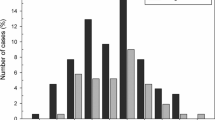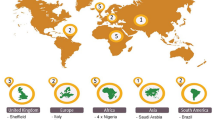Abstract
Salivary gland tumors consist of a group of heterogeneous lesions with complex clinicopathological characteristics and distinct biological behaviors. Worldwide series show a contrast in the relative incidence of salivary gland tumors, with some discrepancies in clinicopathological data. The main aim of this study was to describe demographic characteristics of 599 cases in a population from Central Brazil over a 10-year period and compare these with other epidemiological studies. Benign tumors represented 78.3% of the cases. Women were the most affected (61%) and the male:female ratio was 1:1.6. Parotid gland tumors were the most frequent (68.5% of cases) and patient age ranged from 1 to 88 years-old (median of 45 years old). The most frequent tumors were pleomorphic adenomas (68.4%) and benign tumors were significantly more frequent in the parotid (75.9%), while malignant tumors were more frequent in the minor salivary glands (40%) (P < 0.05). In conclusion, women and the parotid gland were the most affected and pleomorphic adenoma was the most frequent lesion, followed by adenoid cystic carcinoma and Warthin’s tumor.
Similar content being viewed by others
References
Ellis GL, Auclair PL. Atlas of Tumor Pathology. Tumors of the Salivary Glands. Washington: AFIP; 1996.
Seifert G, Sobin LH. World health organization classification of tumours. Histopathological classification of tumors. Berlin, Germany: Springer-Verlag; 1991.
Ansari MH. Salivary gland tumors in an Iranian population: a retrospective study of 130 cases. J Oral Maxillofac Surg. 2007;65:2187–94.
Eveson JW, Cawson RA. Salivary gland tumours. A review of 2410 cases with particular reference to histological types, site, age and sex distribution. J Pathol. 1985;146:51–8.
Spiro RH. Salivary neoplasms: overview of a 35-year experience with 2, 807 patients. Head Neck Surg. 1986;8:177–84.
Dardick I, Burford-Mason AP, Garlick DS, et al. The pathobiology of salivary gland. II. Morphological evaluation of acinic cell carcinomas in the parotid gland of male transgenic (MMTV/v-Ha-ras) mice as a model for human tumours. Virchows Arch A Pathol Anat Histopathol. 1992;421:105–13.
Satko I, Stanko P, Longauerová I. Salivary gland tumours treated in the stomatological clinics in Bratislava. J Craniomaxillofac Surg. 2000;28:56–61.
Williams NP, Boyd DL, Choy L, et al. Salivary gland lesions: a Jamaican perspective. West Indian Med J. 2001;50:62–5.
Vargas PA, Gerhard R, Araujo Filho VJ, et al. Salivary gland tumors in a Brazilian population: a retrospective study of 124 cases. Rev Hosp Clin Fac Med Sao Paulo. 2002;57:271–6.
Ito FA, Ito K, Vargas PA, et al. Salivary gland tumors in a Brazilian population: a retrospective study of 496 cases. Int J Oral Maxillofac Surg. 2005;34:533–6.
Lima SS, Soares AF, de Amorim RF, et al. Epidemiologic profile of salivary gland neoplasms: analysis of 245 cases. Braz J Otorhinolaryngol. 2005;71:335–40.
Al-Khateeb TH, Ababneh KT. Salivary tumors in north Jordanians: a descriptive study. Oral Surg Oral Med Oral Pathol Oral Radiol Endod. 2007;103:e53–9.
Otoh EC, Johnson NW, Olasoji H, et al. Salivary gland neoplasms in Maiduguri, north-eastern Nigeria. Oral Dis. 2005;11:386–91.
Li LJ, Li Y, Wen YM, et al. Clinical analysis of salivary gland tumor cases in West China in past 50 years. Oral Oncol. 2008;44:187–92.
Kayembe MK, Kalengayi MM. Salivary gland tumors in Congo (Zaire). OdontoStomatol Tropicale. 2002;25:19–22.
Acknowledgments
The authors would like to thank FAPEG, FUNAPE, CAPES, CNPq, FO/UFG and IPTSP/UFG for their financial support. The authors are also grateful to Lynne S. P. Brito for her technical support.
Author information
Authors and Affiliations
Corresponding author
Rights and permissions
About this article
Cite this article
de Oliveira, F.A., Duarte, E.C.B., Taveira, C.T. et al. Salivary Gland Tumor: A Review of 599 Cases in a Brazilian Population. Head and Neck Pathol 3, 271–275 (2009). https://doi.org/10.1007/s12105-009-0139-9
Received:
Accepted:
Published:
Issue Date:
DOI: https://doi.org/10.1007/s12105-009-0139-9




